Review: Seacam strobe adaptors
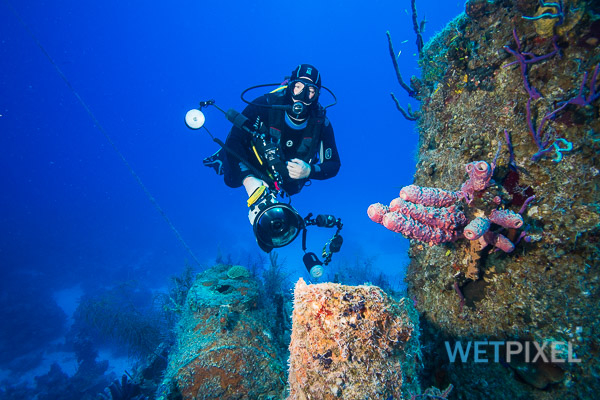
There has been significant discussions on the Wetpixel forums and elsewhere about the quality of color of light that we capture with underwater strobes. Color temperature tends to be much better understood by videographers, as their use of continuous lighting has to blend into the background ambient lighting, lest it become obvious and hence distracting to the viewer. In still photography, this relationship between the color temperature of our strobes and that of ambient light is not as well understood, yet it still exists.
In blue water, cool temperatures of light at, say 5000°K or more, have the effect of creating a somewhat washed out look. It is hard to capture the deep blues that we are all familiar with when we descend into the oceans. For more specifics about color temperatures and their effect on our images, please see Alex Mustard’s excellent article “Strobes and Water Color” on the subject. Of course, you can warm a cool strobe by using a filter, but this sacrifices some output power

For strobe designers and manufacturers, this presents a conundrum. Cool color temperatures travel better through water, so effectively increase strobe output. This is a desirable attribute! Hence is is easier to build a smaller, more portable and travel friendly strobe with a high output if you use cooler color temperatures to do so. To build a strobe that outputs warmer temperatures with a similar strength requires more actual power, and this translates into a physically bigger, heavier unit, which needs bigger batteries to power it and so forth.
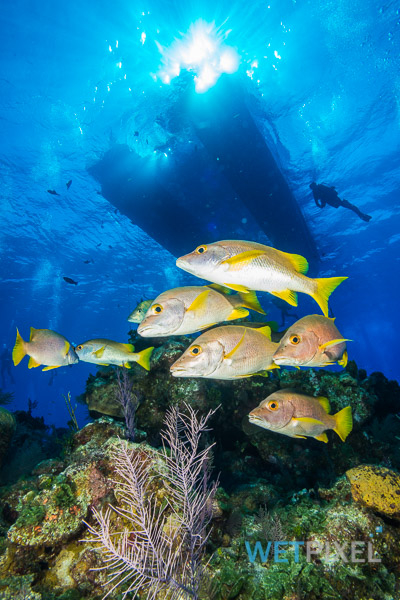
There are a few manufacturers that produce strobes with color temperatures in the 4500°K range. Ikelite (in their DS range), Subtronic and Seacam all have warm color outputs around the 4500°K range. It is no coincidence that they are all make bigger, heavier strobes with large rechargeable battery packs, as this is what is needed to provide an acceptable power output at a warm color. This is also why they are typically more expensive.
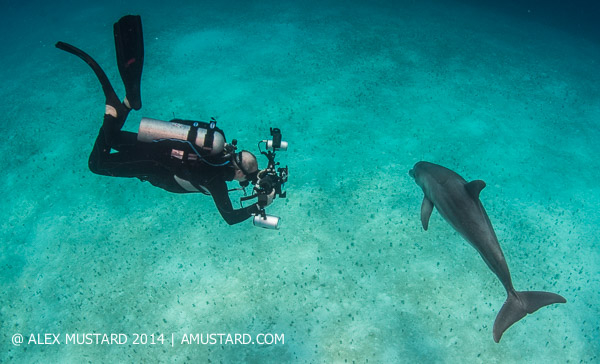
I have been using a pair of Seacam Seaflash 150 Digital strobes for a few months. These are designed to produce 4400°K at 150 Watt/second output, without diffusers. In common with Seacam products, these are beautifully made and designed with a simple control interface and an LED display giving the strobe’s status. They are powered by a bespoke NiMH battery pack with an integrated charging system. They are available in Nikon or Canon versions.
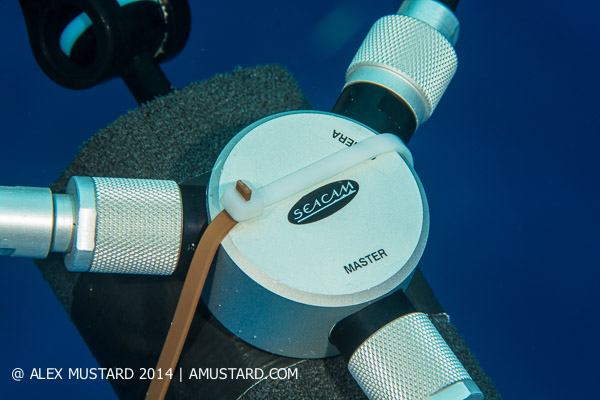
Traditionally, Seacam has limited the appeal of these strobes by incorporating significant i or e TTL compatibility, which for Nikon users, requires a circuit (S-N DDSC) installing into the housing in order to access it. Effectively, this has meant that in order to use the strobes with a Nikon in anything other than manual mode (and with some cameras even in manual mode), it necessitated using a Seacam housing as well.
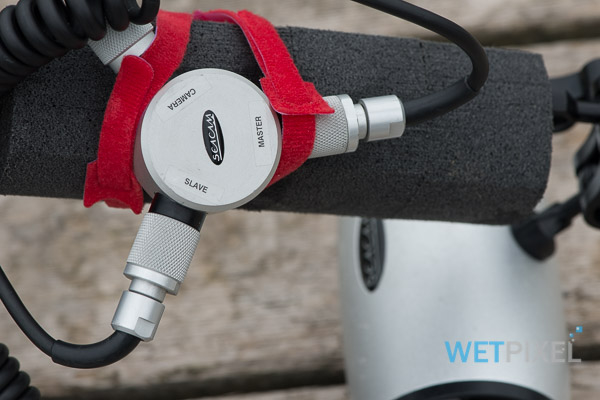
In order to use my Seacam strobes during the coverage of the Bahamas Underwater Photo Week, I approached Harald Hordosch of Seacam at ADEX and asked him to service my strobes and to try and find a solution for using them with my (non Seacam) housing. I was excited when he emailed me to let me know that his engineers had designed a solution that would allow me to retain full functionality with the strobes. Shortly thereafter, a package arrived with my (now fully serviced) strobes and a three way strobe adaptor that allows me to trigger both my strobes from a single bulkhead. The clever bit was that Harald’s engineers had also incorporated the S-N DDSC circuit that allows for full control of the strobes into the adaptor too. In my case, the unit was equipped with a Nikonos input and two S6 outputs, one being labelled as master, and the other as the slave. Hence I have a single (male) Nikonos bulkhead on my housing feeding into a single male Nikonos bulkhead on the adaptor, which in turn feeds via two S6 connectors into the strobes.
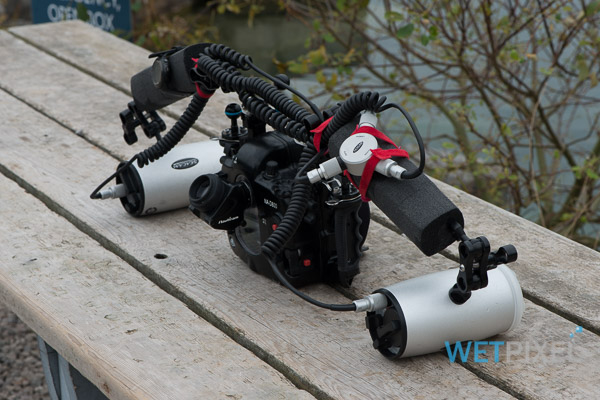
Many Nikonos bulkheads are wired with only the trigger/ground pins active. This allows the camera to trigger an external strobe in manual mode only. In order for the convertor to work in full TTL mode, all 5 pins must be connected.
As mentioned above, the adaptor allows full functionality of all strobe functions. I tend not to use TTL, but the strobes will provide full TTL power output control. In addition, the strobes support all camera flash functions including +/– flash compensation, automatic AF light, pre exposure lamps, automatic standby and rear curtain sync.
The strobe adaptor is equipped with an M8 threaded hole in its underside for attachment. I found that this was not much use with my setup and resorted to using velcro cable ties to attach the adaptor to my strobe arms. The cables as supplied by Seacam are all full length, with both S6 cables and the Nikonos means that their is a lot of cable around the place! Again judicious use of cable ties manages the issue but in future, I would specify a shorter Nikonos cable.

The adaptor does a good job of allowing TTL exposure is required. As mentioned above, I tend to shoot in manual most of the time, but having the option of using TTL is useful. Creatively, the option of using rear curtain synchronisation is a significant addition.
I have discovered that is is critical to switch the master strobe on prior to the slave, and to switch the camera on last. If the slave is activated before the master, it goes into error mode, and the strobes will not work. Maximum flash sync speed (with the D800/D810) is 1/320 second (when camera setting e1 is set to 1/320).
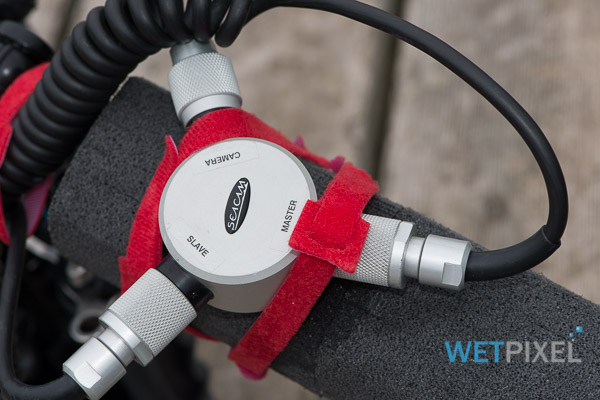
The Seacam strobe adaptor is an elegant solution for those seeking to use their strobes with other manufacturers’ housings. This gives wide-angle shooters another useful tool in the pursuit of achieving perfect lighting.
Many thanks to Harald Hordosch of Seacam for his assistance with this review. He assures me that the strobe adaptor will be available as a commercial product soon. Please contact him for more details.
FTTC Disclosure
Seacam provided the strobe adaptor as a free of charge prototype for the review. The Seaflash 150s are the reviewer’s own.